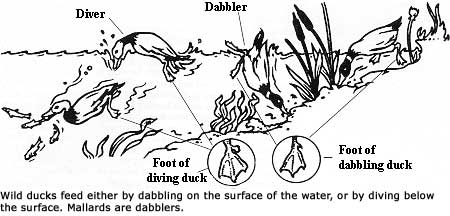
Mallards can be found almost anywhere in the world - including Nebraska. You'll also find mallard ducks in locations like Asia, Africa and South America.
Mallards are known as dabbling ducks. It is a medium-to-large duck that is easy to recognize. The male ducks have a glossy green head with a white collar around the neck. The female is mostly brown. Both have orange feet. Both males and females have a blue "speculum" bordered with white on both sides. A duck's "speculum" is the back portion of its secondary feathers.
What is dabbling? A mallard is a dabbling duck because it tips its body into the water bill first. The tail sticks right out of the water into the air. With their bills, they look for food. Mallards do eat snails, insects and small fish. But, 90% of their diet is grass seeds and other plants - including pondweeds.

If you are tempted to raise a few adorable ducklings, read this from Raising a Few Ducks - University of Michigan
Nothing brings out the maternal or paternal instinct more quickly than very young ducklings. Before you plunge, however, remember that:
- They can be very messy!
- Duck feed is not always available.
- They grow up to be adult ducks and then what do you do?
- They require care, housing and equipment.
- They have very fragile legs. They should be held by the neck and lifted with the palm of the hand under their breast.